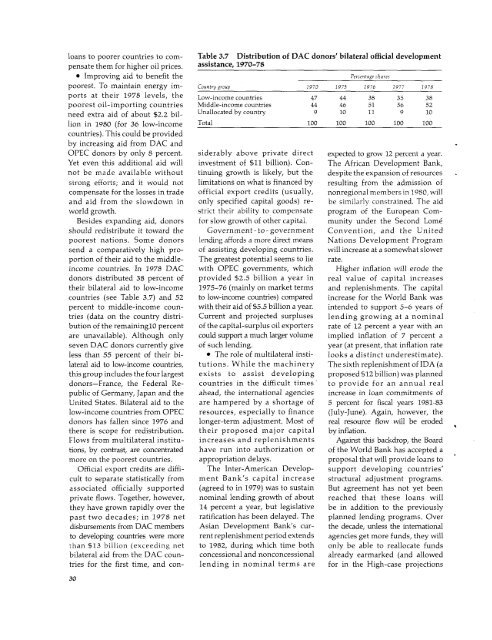World Bank Document
World Bank Document
World Bank Document
- No tags were found...
You also want an ePaper? Increase the reach of your titles
YUMPU automatically turns print PDFs into web optimized ePapers that Google loves.
loans to poorer countries to com- Table 3.7 Distribution of DAC donors' bilateral official developmentpensate them for higher oil prices. assistance, 1970-78* Improving aid to benefit the Percentage sharespoorest. To maintain energy im- Country group 1970 1975 1976 1977 1978ports at their 1978 levels, the Low-income countries 47 44 38 35 38poorest oil-importing countries Middle-income countries 44 46 51 56 52need extra aid of about $2.2 bil- Unallocated by country 9 10 11 9 10lion in 1980 (for 36 low-income Total 100 100 100 100 100countries). This could be providedby increasing aid from DAC andOPEC donors by only 8 percent. siderably above private direct expected to grow 12 percent a year.Yet even this additional aid will investment of $11 billion). Con- The African Development <strong>Bank</strong>,not be made available without tinuing growth is likely, but the despite the expansion of resourcesstrong efforts; and it would not limitations on what is financed by resulting from the admission ofcompensate for the losses in trade official export credits (usually, nonregional members in 1980, willand aid from the slowdown in only specified capital goods) re- be similarly constrained. The aidworld growth. strict their ability to compensate program of the European Com-Besides expanding aid, donors for slow growth of other capital. munity under the Second Lom6should redistribute it toward the Government-to-government Convention, and the Unitedpoorest nations. Some donors lending affords a more direct means Nations Development Programsend a comparatively high pro- of assisting developing countries. will increase at a somewhat slowerportion of their aid to the middle- The greatest potential seems to lie rate.income countries. In 1978 DAC with OPEC governments, which Higher inflation will erode thedonors distributed 38 percent of provided $2.5 billion a year in real value of capital increasestheir bilateral aid to low-income 1975-76 (mainly on market terms and replenishments. The capitalcountries (see Table 3.7) and 52 to low-income countries) compared increase for the <strong>World</strong> <strong>Bank</strong> waspercent to middle-income coun- with their aid of $5.5 billion a year. intended to support 5-6 years oftries (data on the country distri- Current and projected surpluses lending growing at a nominalbution of the remaininglO percent of the capital-surplus oil exporters rate of 12 percent a year with anare unavailable). Although only could support a much larger volume implied inflation of 7 percent aseven DAC donors currently give of such lending. year (at present, that inflation rateless than 55 percent of their bi- * The role of multilateral insti- looks a distinct underestimate).lateral aid to low-income countries, tutions. While the machinery The sixth replenishment of IDA (athis group includes the four largest exists to assist developing proposed $12 billion) was planneddonors-France, the Federal Re- countries in the difficult times' to provide for an annual realpublic of Germany, Japan and the ahead, the international agencies increase in loan commitments ofUnited States. Bilateral aid to the are hampered by a shortage of 5 percent for fiscal years 1981-83low-income countries from OPEC resources, especially to finance (July-June). Again, however, thedonors has fallen since 1976 and longer-term adjustment. Most of real resource flow will be erodedthere is scope for redistribution. their proposed major capital byinflation.Flows from multilateral institu- increases and replenishments Against this backdrop, the Boardtions, by contrast, are concentrated have run into authorization or of the <strong>World</strong> <strong>Bank</strong> has accepted amore on the poorest countries. appropriation delays. proposal that will provide loans toOfficial export credits are diffi- The Inter-American Develop- support developing countries'cult to separate statistically from ment <strong>Bank</strong>'s capital increase structural adjustment programs.associated officially supported (agreed to in 1979) was to sustain But agreement has not yet beenprivate flows. Together, however, nominal lending growth of about reached that these loans willthey have grown rapidly over the 14 percent a year, but legislative be in addition to the previouslypast two decades; in 1978 net ratification has been delayed. The planned lending programs. Overdisbursements from DAC members Asian Development <strong>Bank</strong>'s cur- the decade, unless the intemationalto developing countries were more rent replenishment period extends agencies get more funds, they willthan $13 billion (exceeding net to 1982, during which time both only be able to reallocate fundsbilateral aid from the DAC coun- concessional and nonconcessional already earmarked (and allowedtries for the first time, and con- lending in nominal terms are for in the High-case projections30
















